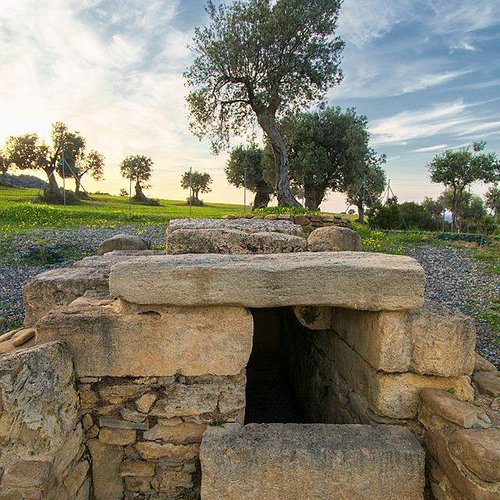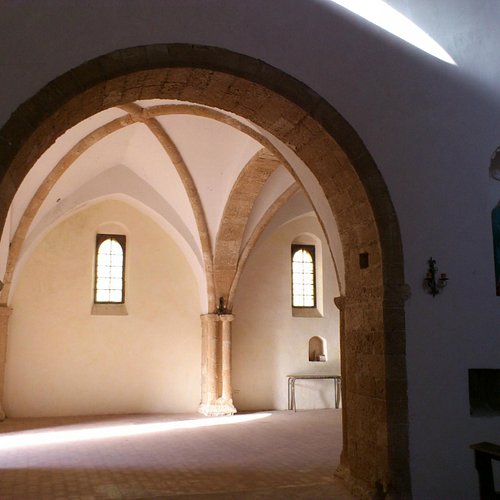Things to do in Cariati, Calabria: The Best Sights & Landmarks
Discover the best top things to do in Cariati, Italy including Tomba Bretia Cariati, Cattedrale di San Michele Arcangelo, Chiesa Degli Osservanti, Centro Storico Cariati, Torre del Pile, Chiesa della Santissima Trinita a Cariati, Porta Pia, Palazzo del Seminario, Palazzo Vescovile, Porta Pia.
Restaurants in Cariati
1. Tomba Bretia Cariati
2. Cattedrale di San Michele Arcangelo
Overall Ratings
4.0 based on 42 reviews
Originally medieval Cathedral of St. Michael the Archangel Cariati was originally dedicated to St. Peter. The structure , built in the fifth century AD, has suffered in the course of the eighteenth century work of expansion and renovation . The current name was adopted in the course of 1741. Nicholas was the Bishop of Cariati Goliath that brought about the transformation of the church into a neoclassical temple and , in 1857 , inaugurated the new facility built by the master Carmine Roger, designed by architect Horace Neapolitan snapper .The façade is preceded by a portico , from which rises the bell tower , built in 1649. Architectural Of particular interest is the dome covered with tile polychrome majolica . Dome that has been recently restored , the work you have completed in December of 2012.The interior has three naves, separated by massive Ionic columns , arranged in pairs. In each aisle there are three altars. Of particular interest are the chapels dedicated to the Blessed Sacrament and San Cataldo , the latter with an artistic Baroque marble altar , the work of the Neapolitan school of 700. On the high altar is placed a painting of the Assumption of the Virgin Mary , painted by Raphael Aloisio Calabria . On either side of the chancel stalls are placed in a precious wooden choir century in baroque style. Sky on the ceiling of the nave is the mural painted in tempera depicting St. Michael the Archangel banishes Lucifer and the rebellious angels from Heaven , the work carried out in 1912 by the Neapolitan painter Luigi Taglialatela .
3. Chiesa Degli Osservanti
Overall Ratings
4.0 based on 7 reviews
The Church of the Observant is the most important monument of Cariati, also known as the Church of Santa Philomena. It was built around 1440 by the Florentine Bonaccorso Caponsacco, near the monastery of the Friars Minor, and is formed by two distinct complexes: the Oratory of Santa Filomena and the Oratory of the Madonna della Catena. The Oratory of St. Philomena is in the Gothic style, with a porch and arched stone doorway; The interior has a single nave with apse surmounted by a dome and octagonal decorated with mosaics; chapels with vaulted ceilings. The Oratory of the Madonna della Catena has The facade is pierced by a rose window above the portal with an enrollment of 1441.
4. Centro Storico Cariati
Overall Ratings
4.0 based on 190 reviews
Cariati is a town of 8,626 inhabitants in the province of Cosenza. It is a town of Ionian Calabria and is located midway between the towns of Sybaris and Croton.History [edit | edit source ]Origin of the name [edit | edit source ]There are different versions about the origin of the name of the town. Could result from catherine (or Carina ), ie, grace , beautiful and graceful . Alternatively, it is possible that the name derives from an original name " Diana Caryatid " , tied to a place sacred to Diana. In the tenth century the name came Korion , which derives from the greek Curuai ( Greek inhabitants of caries ) . A final hypothesis is connected to the fact that Cariati was originally situated on the plain where now stands the village of Santa Maria ; as was often the target of attacks by the Saracens of Khayr al- Din Barbarossa , the inhabitants were forced to move from the marina to the current location , from transport wagons derives the name " Carriati ," which in turn derives from the name .The Brettii (or Bruzi ) [edit | edit source ]In the area of Cosenza has documented the presence of Brett V- IV century BC Between the fourth and third centuries BC also the territory of Cariati was frequented by these populations , devoted to agriculture and pastoralism .In an olive grove on a hill on the outskirts of the village ( town " Timpa del Salto " in the district Prujja ) on the occasion of the farm work was found in 1978 a tomb ( " grave Brettia " ), dating from about 330 BC The burial was discovered intact , consists of rectangular blocks of sandstone that contained a small area of about 2 square meters . The tomb was internally painted with scenes from the life of a warrior. The body was accompanied by a rich array , consisting of bronze armor , with belt, helmet and sword , jars and dishes, all on display at the Museum of Sybaris. In the area were also found in other tombs , but plundered and destroyed.Remains of ancient dwellings , stone mortars , ceramic jars are clues to the presence of a settlement , favored by the dominant position of the city.Roman domination and the Middle Ages [edit | edit source ]The city was ruled by Rome and had Paternum name . Bishopric since the beginning of Christianity, appears to have had as bishop Menecrates , present at the synod of Rome in March 1 499. In one of his letters , St. Gregory ( 540-604 ) recommends that the church of the bishop of Reggio Cariati . According to some sources , in the eleventh or twelfth century , the Diocese of Cerenza ( Geruntia ) was combined with that of Cariati , although only in 1342 can be dated to a document which explicitly mentions a " Bishop of Cariati and Cerenza " . [ 2 ]Feudalism [edit | edit source ]Feudal lord in the year 1260 was Matthew Cariati [3] , in whose name the historians are not certain ; at the beginning of the fourteenth century we find Gentile di San Giorgio, who took over the Ruffo Montalto . On the initiative of Covella Ruffo , and with approval of Pope Eugenius IV , Cariati became an Episcopal ( 1437 ) . The feud was assigned to Riario of Imola in 1479 , then to the Sanseverino, Coppola and then to the Borgias [4]. In 1495 King Charles VIII of France , occupied the Kingdom of Naples gave the county to Michael Riccio , which was removed with the defeat of the French . [5] In 1505 the property was given to the principles Spinelli, who were holders of Cariati until the abolition of feudalism .Monuments and places of interest [edit | edit source ]Religious Architecture [edit | edit source ]Cathedral [edit | edit source ]Dome of the Cathedral of St. Michael the ArchangelThe church was built in the fifth century and was rebuilt , under the episcopate of Bishop Nicholas Goliath in 1857 , the work of Carmine Ruggiero.The façade is preceded by a portico , from which rises the bell tower was built later. The dome is covered with tile polychrome majolica .The interior has three naves, separated by massive Ionic columns , arranged in pairs.Church of the Observant [edit | edit source ]The church was built in 1441 at the behest of Bonaccorso Caponsacco .Just a few hundred meters from the walls of the village . It is a work of monastic architecture style ' Late Gothic ' and maintains a quadrangular apse .The portal of entrance to the building is shaped like a pointed stone . The dome has a ribbed lined with polychrome majolica tiles .Civil architectures [edit | edit source ]Main entrance to the medieval town ( Porta Pia )Course XX SettembreBorgo [edit | edit source ]Village on the shore of the sea, accessible from several points but with the current main entrance consists of Porta Pia . The first nucleus of the old town was built as a fortified strategic place in the Byzantine period , between the ninth and tenth centuries .The walls were fortified when the town was a family feud Ruffo . The full length of the perimeter is about a mile , interspersed with eight towers .Porta Pia (or Porta Nuova ) and during XX Settembre [edit | edit source ]Immediately after the main entrance of Porta Pia and the Porta Nuova , is the Palazzo del Seminario , built in the first half of the seventeenth century .From the door starts the course XX Settembre , the main street once " Via Duomo " ) , along which lies before the Cathedral of St. Michael the Archangel , and soon after , the Bishop's Palace , preceded by the village square (Piazza Plebiscito ), where is the bell tower with a clock , built in 1904.Tomb Brettia [edit | edit source ]The burial tomb consists of a " subterranean room " , located on a hill close to the sea in Salto, easily accessible from the 106 .Between the fourth and third centuries A.C. Decayed was the site of settlements Brezie of people engaged in agriculture and pastoralism . Decayed for a long time was settled by this civilization that, from this strategic point on the sea, dominated much of the territory . What comes to us in this civilization is a grave found on a hill on the outskirts of Cariati , in the midst of olive trees ( came to light after earthworks for agriculture) . Dating back to around 330 BC , the tomb consists of a rectangular block of sandstone beds that formed a room of about 2 m2 ; it appeared intact , inside there was a fresco which probably accounted for the life of the warrior " brezio " whose name comes from " TOMB Brettia ", which is supposed to be the head of the local community. Inside were found the body of the warrior with a lot of valuable items such as his bronze armor , a belt, a helmet , a sword , amphorae , plates , and other objects of his funeral . At the moment all of these objects are on display at the Museum of Sybaris , and nothing to prevent the hills of Cariati may still be other graves of warriors of this or other civilizations.
6. Chiesa della Santissima Trinita a Cariati
Overall Ratings
3.0 based on 1 reviews





